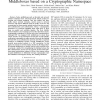282 search results - page 43 / 57 » Collaborative Intrusion Prevention |
ESORICS
2009
Springer
14 years 8 months ago
2009
Springer
1 There are increasing deployments of networked embedded systems and rising threats of malware intrusions on such systems. To mitigate this threat, it is desirable to enable common...
KDD
2002
ACM
14 years 8 months ago
2002
ACM
Traditional intrusion detection systems (IDS) detect attacks by comparing current behavior to signatures of known attacks. One main drawback is the inability of detecting new atta...
ICC
2009
IEEE
14 years 2 months ago
2009
IEEE
—Today, middleboxes such as firewalls and network address translators have advanced beyond simple packet forwarding and address mapping. They also inspect and filter traffic, ...
INFOCOM
2009
IEEE
14 years 2 months ago
2009
IEEE
—A major threat to data networks is based on the fact that some traffic can be expensive to classify and filter as it will undergo a longer than average list of filtering rule...
ACSAC
2008
IEEE
14 years 2 months ago
2008
IEEE
In its most general form, an attack signature is a program that can correctly determine if an input network packet sequence can successfully attack a protected network application...


